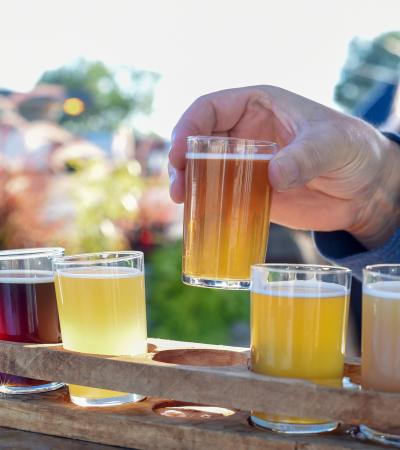Shorts & Stouts is a monthly short story discussion group held a local brewery. Each month the discussion focuses on a pair of stories by a single author.
No stout purchase is required for participation. :)
Advanced Planning
A couple questions went into the initial planning for this event: What kind of literary discussion group could we offer that hasn’t been overdone and wouldn’t commit participants to reading an entire novel? And where could such a discussion be held (outside of the library) that’s fun, social and enables a new community partnership?
The answers came like inspired bolts of lightning: Short stories! At a brewery!
The equally inspired name of the program, Shorts & Stouts, arrived shortly thereafter.
There are certain leisures and liberties allowed by choosing short stories for discussion. Because of the brevity, folks can choose at the last minute whether to participate, try out an author they wouldn’t otherwise, or re-read a story they may have read before — all things they wouldn’t necessarily be willing to do with a novel. Furthermore, a good short story accomplishes the same level of poignancy as a novel.
The next steps were to determine location, date and time. The first brewery we contacted jumped at the idea (with thanks, Dry Ground Brewing), and they offered one of their side rooms for the discussion. Together we decided to try Mondays because they were generally slower nights for both the brewery and library. For us, 7 p.m. has worked well as a start time, with the discussion lasting no more than an hour.
After that, the pre-planning came down to choosing authors and stories. At each meeting we discuss a pair of stories by a single author. Having a pair of stories gives a larger sample of an author’s themes and style, as well the opportunity to compare and contrast, without being an overwhelming amount of reading.
We chose to go with widely recognized short story authors — masters of their craft, so to speak. For our limited run of six sessions in 2017, we went with the following authors and stories:
- Flannery O’Connor, “A Good Man Is Hard to Find” and “Good Country People”
- Ernest Hemingway, “A Clean Well-Lighted Place” and “The Short Happy Life of Francis MacComber”
- Gabriel Garcia Marquez, “The Very Old Man with Enormous Wings” and “The Handsomest Drowned Man in the World”
- Shirley Jackson, “The Lottery” and “The Possibility of Evil”
- Raymond Carver, “Cathedral” and “A Small, Good Thing”
- Eudora Welty, “A Worn Path” and “Why I Live at the P.O.”
Marketing
Social media has been our primary source for marketing; our town heavily utilizes Facebook and Instagram. Posters and fliers, spots on the local NPR station and press releases have also been effective.
But as trite as it sounds, word of mouth has probably been our source for the most repeat participants. Someone brings a friend, and then that friend brings a friend, and next thing you know we have new regular attendees. Encourage your participants to talk it up!
Budgeting
The program is as free as you want it to be. The only potential expenses are meeting space and copies of the stories.
Our meeting space was donated. Beer is optional.
Most of the stories/authors we featured for discussion were already available to check out from the library (including physical and digital copies). Many of the stories were also part of the public domain and could be linked to and/or distributed freely. In choosing stories for discussion, I also checked to see if they were available to read on the internet somewhere.
Because of copyright concerns, I, of course, didn't link to or photocopy any stories whose posting seemed questionable. But there is a lot of stuff available out there and a simple Google search can provide you with a wealth of stories.
Day-of-event Activity
As facilitator, I would re-read the stories and come up with discussion questions. I'd also prepare a little biography about the author; a great source of discussion is often how the author's life relates to his/her work.
I'd make photocopies when applicable and gather materials about other library events to advertise.
Outside of that, there isn't much to prepare for.
Program Execution
People arrive, grab a beer, and the discussion begins. People get up to refill their beers as needed. Sometimes they order pizza. Not much to it beyond that, though one question is always which of the two stories is best to lead off with. Sometimes the participants dictate which one they want to discuss more; sometimes you have to go with your gut.
Over the three years we've done this program, the attendance has averaged 15 to 20 per discussion. We've had as few as 8 and as many as 40. But that 15-to-20 average seems to be the magic number for a really good discussion. Too many people and it starts to feel like a lecture rather than a discussion. Too few and things can get a little awkward; people feel put on the spot.
The discussions are just good. Enriching and thoughtful.
A good short story often does this better than a novel. With fewer words to wrap your brain around, the discussions can go more in depth. You can discuss the WHOLE story, not just bits and pieces. Themes can be more deeply explored. Single sentences can be picked apart. Symbols can be identified and linked.
One gratifying outcome is that there has been at least one new participant at nearly every discussion, meaning that word is getting out and continues to draw new participants in. It continues to fill a need. Having new folks keeps the discussions fresh.
Advice
If possible, set up your room in a circle or square. Participants being able to see in each other's eyes can foster better discussion.
There are lots of good discussion questions out there already. Yes, come up with your own, but utilize outside resources as well. Shmoop.com has some get information in this regard.
With story choice, we've run the gamut. Variety seems to be the key. We have folks that will only show up for the classics (e.g., Hawthorne, Twain), folks who will only show up if they recognize the story (e.g., Shirley Jackson's "The Lottery"), folks who only show up for sci-fi (e.g., Vonnegut, Bradbury), folks who will only show up for stories with a strong social message (e.g., Atwood, Baldwin), and so forth. So, go for diversity in gender, ethnicity, culture and time period.
Attached at the right are the fliers we used for the last two years' programming (totaling 24 authors/48 stories). Each discussion brought something new. Some were easier than others to pull off, but I wouldn't have substituted any of the authors for another.



